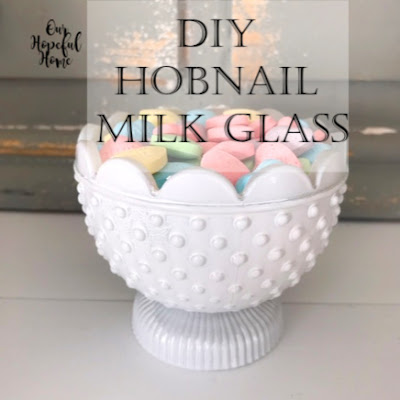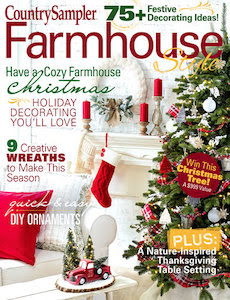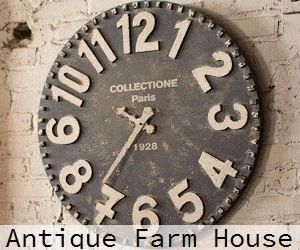Vintage hobnail milk glass is a popular collectible for many vintage decor lovers. However, some areas of the country seem to have an abundance of it, while other areas seem to suffer a scarcity. So what's a poor hobnail milk glass lover to do? You already know my answer: DIY it! Trust me, it's a quick, easy and fairly inexpensive project, especially if you already have some of the supplies on hand like I did.
This post contains affiliate links. A purchase of any one of these items helps to support this blog and its creative efforts at no cost to you. To read more, please see my disclosure page.
I recently shared this thrift store beauty in Thrill of the Hunt #96. I picked it up for 99 cents at Goodwill. While I loved that it was clear hobnail glass, I still wished that it was hobnail milk glass instead. So I took matters into my own hands.
DIY Hobnail Milk Glass Supplies
1. white gloss enamel paint (and paint brush) for thicker coat and more opaque finish OR
2. white spray paint with gloss (or without gloss for more of a matte finish)
3. thrifted clear hobnail glass bowl, cup, plate, vase, etc.
4. newspapers to protect your painting surface/area and, if necessary, something to elevate your piece while painting it (I used a plastic Solo cup).
4. newspapers to protect your painting surface/area and, if necessary, something to elevate your piece while painting it (I used a plastic Solo cup).
How To Make Your Own Hobnail Milk Glass
I highly recommend using spray paint, based on experience. I initially painted the bowl with a matte acrylic paint and I just didn't like the brush marks it left and the coverage it provided. It also took forever to dry. So I used hot water (yes!) and washed the first coat off, thankfully. (This was about an hour after I initially painted it.)
But if you choose the paint brush method, just go for it. You'll most likely need at least 3-4 coats depending on the type of paint you use. Just make sure each coat is dry before adding another coat.
As for spray painting, you'll want to use multiple, super thin coats, holding the can at least 10-12 inches away from your glass piece. I learned the hard way that if you hold the can too close, you run the risk of actually smearing the previous coat by the sheer force of the spray. And wait at least one minute between coats. This method will ultimately give you the best finish, and hopefully help you avoid drips, which I'll admit is easier said than done.
TIP: If you think you'll ever use whatever you're painting for flowers or food, go ahead and skip painting the inside of it to be safe.
Here's the finished product after 6 coats of spray paint. Since I'm going to be using it as a candy dish as well as a vase I didn't paint the inside of it.
Here you can see my DIY hobnail milk glass candy dish side by side with my Dollar Tree treasures -- modern hobnail milk glass candle holders. Once I get my DIY farmhouse shelves in the dining room styled with my ironstone and hobnail milk glass collection I'll be sure to share!
Don't Forget To Pin It!

Since you can't really hold something in your hand while spray painting it, I placed the bowl on top of a Solo cup to make things easier.
Here it is after one coat. Slow and steady wins the race on this one. Super light coats, from one to ten minutes apart, should do the trick. Always follow the instructions on your paint and/or spray paint can. And be sure to set up shop in a well-ventilated area. I do all painting and spray painting in my garage with the big door OPEN.
And here it is after two coats.
This was after 3-4 coats. Can you see the difference? At this point I thought I was done, but when I turned the bowl right side up I saw a few spots around the rim near the top (beneath the decorative scalloped edge) that needed to be sprayed while right side up as opposed to being upside down on the cup. Kind of like filling in the blanks.
Suffice it to say you'll have to inspect your piece from all angles to get a true sense of coverage before you can call it finished. And as I stated above, you can always use a non-glossy paint, but I really believe that the glossy paints are more true to the finish found on genuine milk glass.
Suffice it to say you'll have to inspect your piece from all angles to get a true sense of coverage before you can call it finished. And as I stated above, you can always use a non-glossy paint, but I really believe that the glossy paints are more true to the finish found on genuine milk glass.
Here's the finished product after 6 coats of spray paint. Since I'm going to be using it as a candy dish as well as a vase I didn't paint the inside of it.
While the hobnail bumps on the candy dish, being vintage, are a little bit smaller than the bumps on the other more modern milk glass pieces I have in my collection, I do think it fits in pretty seamlessly.
Hug me. Cutie. Love You. Kiss me. These conversation hearts are precious and look fabulous in this DIY vintage hobnail milk glass candy dish.
Here you can see my DIY hobnail milk glass candy dish side by side with my Dollar Tree treasures -- modern hobnail milk glass candle holders. Once I get my DIY farmhouse shelves in the dining room styled with my ironstone and hobnail milk glass collection I'll be sure to share!
Well, that's it until next time, friends!
I hope you've enjoyed reading about my
DIY Hobnail Milk Glass.























Leave a Comment!
I never would have thought that you painted this piece!! It looks as if it is vintage milk glass!! Great project! Thanks so much for sharing!!
Hugs,
Debbie
It's a great resemblance, Kathleen! Would you believe I found a large hobnail pitcher for $3 this weekend? I couldn't grab it fast enough. ;)
This looks so good!
I honestly prefer my Fenton hobnail, but I think you did a lovely job! Not painting the inside is a really good idea, too. Finding milk glass reasonably priced is getting harder all the time; it is one of my major addictions!
Oh wow!! I never would have thought to do this. It doesn't look painted at all - it looks like the real thing!
Post a Comment